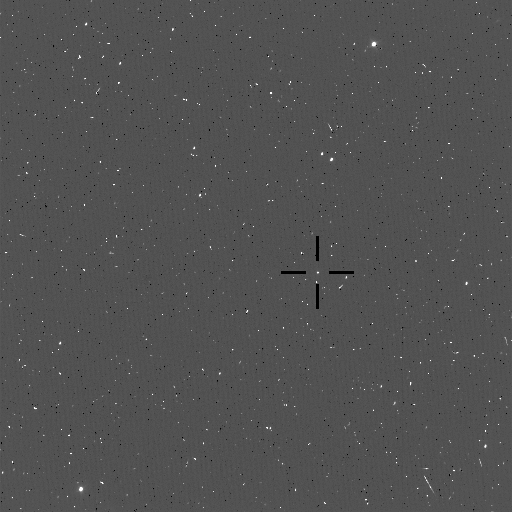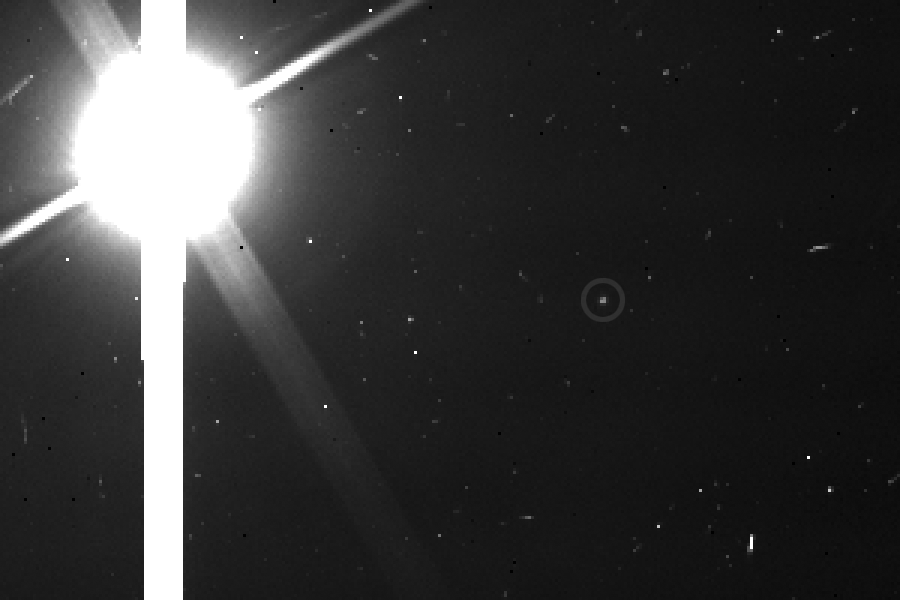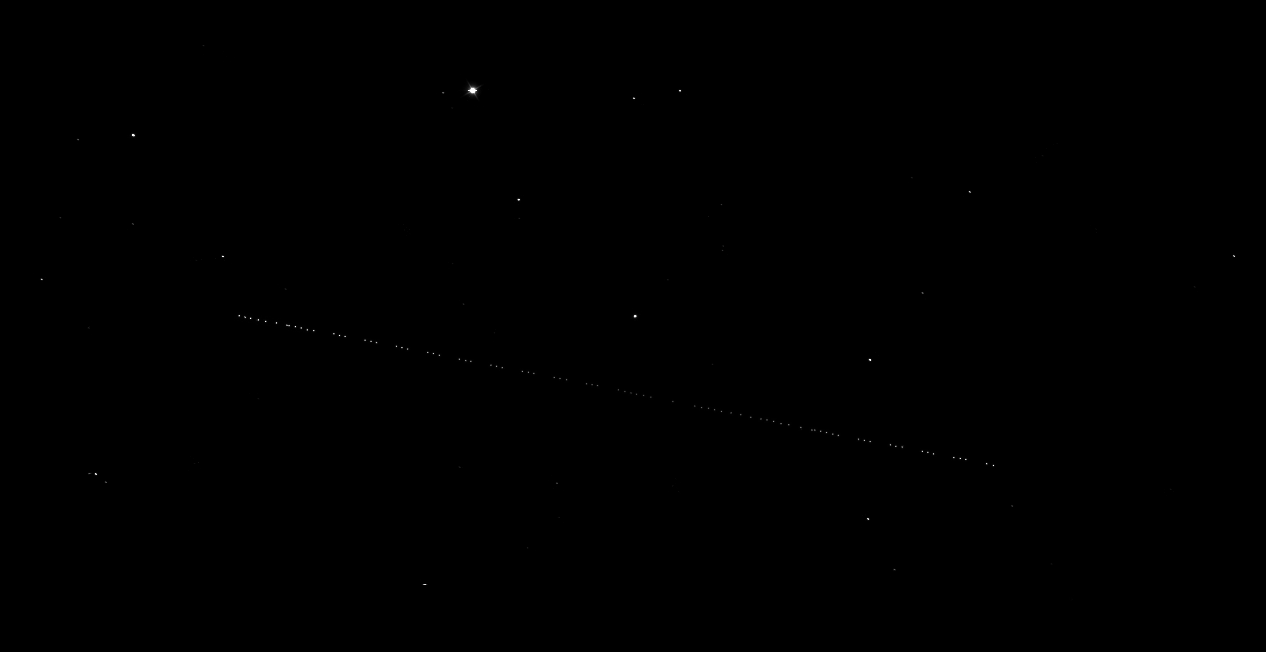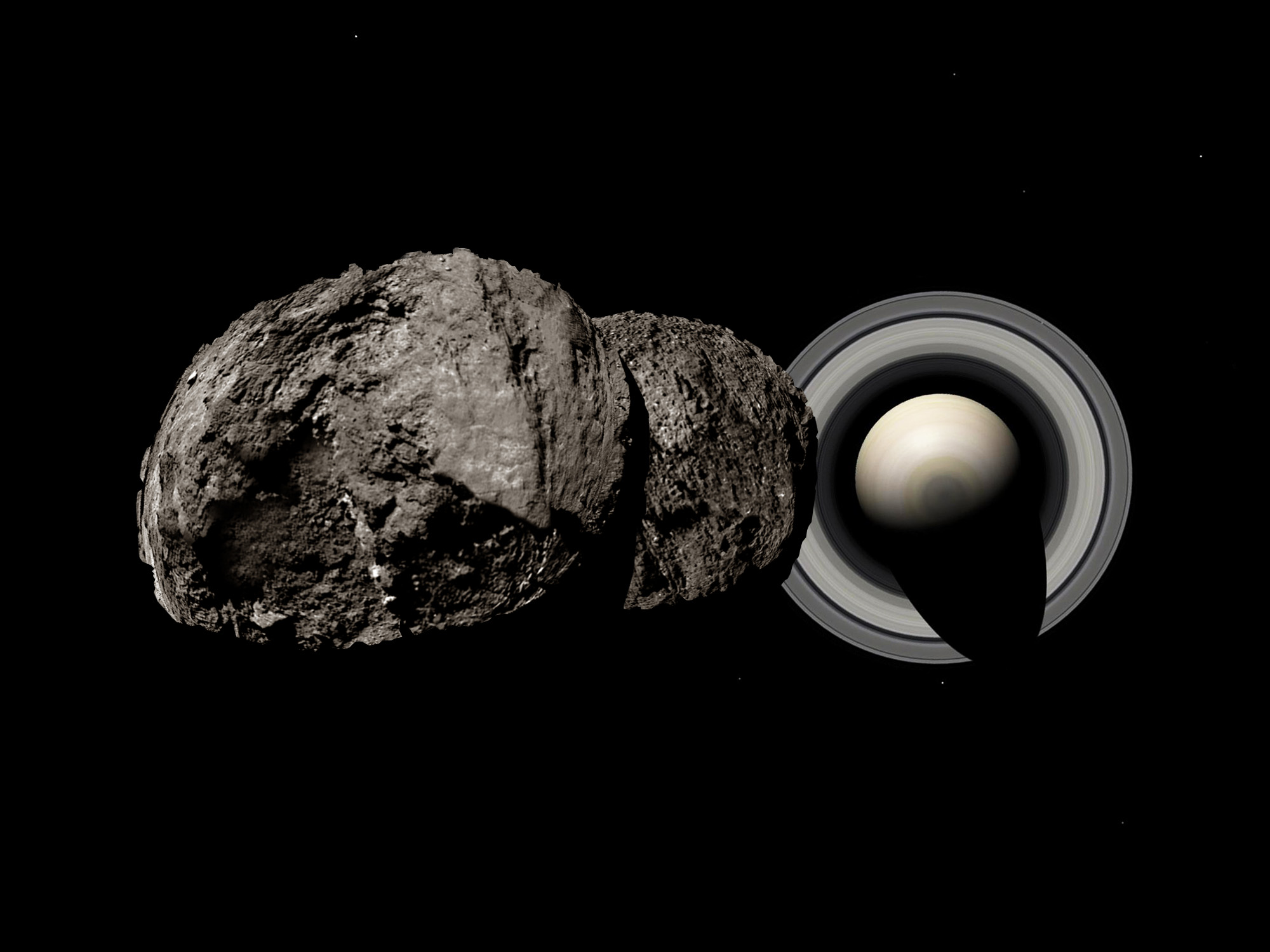← back to Outer Saturnian Moons
![]() Kiviuq is ∼17 kilometers in size and thus one of the large Irregular moon of Saturn. It has been discovered in 2000 joint with eleven other outer moons. Kiviuq’s mean distance to Saturn is ∼11½ million kilometers, with one revolution around the planet on a prograde orbit requiring 1 year, 2 months and 3 weeks. Joint with Ijiraq, S/2005 S 4, S/2019 S 1, and S/2020 S 1 which share very similar orbital elements, its distance to Saturn is the lowest and its orbit period the shortest of all Irregulars. Kiviuq is a member of the Inuit family.
Kiviuq is ∼17 kilometers in size and thus one of the large Irregular moon of Saturn. It has been discovered in 2000 joint with eleven other outer moons. Kiviuq’s mean distance to Saturn is ∼11½ million kilometers, with one revolution around the planet on a prograde orbit requiring 1 year, 2 months and 3 weeks. Joint with Ijiraq, S/2005 S 4, S/2019 S 1, and S/2020 S 1 which share very similar orbital elements, its distance to Saturn is the lowest and its orbit period the shortest of all Irregulars. Kiviuq is a member of the Inuit family.
From our Cassini measurements, the rotation period was determined to 21 h and 59 min ± 10 min. The Kiviuq lightcurves show extreme amplitudes, indicative of a very elongated shape of this moon or possibly even of a binary or contact-binary object.
Table of contents(1) Astronomical and physical properties |
 |
 |
Fig. (left): Short animation of Cassini images of Kiviuq while moving through constellation Leo on 31 Aug 2010. In the first image, the object is marked by a black cross. Image details: 21 frames; time span: 1:18 h; exposure times: 38 sec; range: 9.4 million km; Cassini orbit: rev 137. The background stars move through the field of view because the camera of the fast moving Cassini spacecraft was tracking Kiviuq. The slight horizontal jitter of Kiviuq is due to improper tracking at the arcseconds level. Flickering bright spots or streaks stem from cosmic-ray hits on the camera’s CCD detector, fixed bright or dark pixels are incorrectly calibrated hot or cold pixels on the CCD, respectively. The space background, in reality pitch black, is displayed in dark gray because this makes visibility of the object easier. Image IDs: N1661916804 to N1661921460.
Fig. (right): Kiviuq (brightness: ∼14 magnitudes) passes 3-mag bright star ε Leonis while it was observed by the Cassini spacecraft in April 2014. The star is hopelessly overexposed, the vertical stripes are a blooming effect in the CCD of the camera. Image details: Cassini orbit: rev 203; exposure time: 220 sec; observation start-time: 2014-04-19T16:24:17 UTC; camera: NAC; Image ID: N1776619355; no binning. A calibrated, 3x zoomed, and cropped image version is shown here.
This page is intended to compile (much of) our knowledge of Kiviuq in compact form. Its main focus will lie on the documentation of my Cassini-ISS work (observation planning and data analysis), but will also provide general information obtained from other work, like discovery circumstances and orbital and physical parameters. It will not include the raw data (images or spectra) taken by the Cassini spacecraft, these are available at NASA’s Planetary Data System (PDS). For further reading on Kiviuq and on Irregular moons of Saturn in general, see the reference list at my outer-Saturnian moons page.
This website is still in the early stages of development. As soon as papers will be reviewed or other information will be processed appropriately, more content will be added. I will remove this note when the page will be close to completion.
Last update: 19 May 2023 — page content is best displayed on a screen at least 1024 pixels wide
(1) Astronomical and physical properties
| Moon name | Saturn range | Orbit period | Orbit direction | Size | Rotation period | Discovery year |
| Kiviuq |
million km
|
years
|
prograde |
∼ km
|
∼ h
|
2000 |
Basic information about Kiviuq is offered in tabular form:
(1A) Designations and discovery circumstances
(1B) Orbit parameters
(1C) Physical parameters (body properties)
![]() ← Tables (1A) to (1C) in text format
← Tables (1A) to (1C) in text format
Most fundamental values are highlighted in red. The notes offer explanations, calculations, accuracies, references, etc. The data were obtained from spacecraft as well as from ground-based observations.
(1A) Designations and discovery circumstances
| Moon name(1) | Kiviuq | IAU number(3) | Saturn XXIV | First observation date(7) | 07 Aug 2000 | ||
| Moon abbrev. (TD)(2) | Kiv | Provisional desig.(4) | S/2000 S 5 | Announcement date(7) | 18 Nov 2000 | ||
| SPICE ID(5) | 624 | IAU circ. announcement(7) | no. 7521 | ||||
| Also-used label(6) | S24 | Discoverers(8) | B. Gladman et al. |
Notes for Table 1A:
(1) Kiviuq’s name was announced on 08 Aug 2003 in IAU circ. 8177. It is named after Kiviuq, eternal wanderer with supernatural powers and legendary hero of the epic stories of the Inuit of the Arctic regions of northern Canada, Alaska and Greenland.
(2) I use this 3-letter abbreviation in the diagrams of my publications simply for practicability reasons. These have no offcial character.
(3) Moon numbers are assigned by the International Astronomical Union (IAU)’s Committee for Planetary System Nomenclature. For satellites, roman numeral designations are used.
(4) Designation given to the object in the first announcement; the guidelines are explained here.
(5) SPICE is a commonly-used information system of NASA’s Navigation and Ancillary Information Facility (NAIF). It assists engineers in modeling, planning, and executing planetary-exploration missions, and supports observation interpretation for scientists. Each planet and moon obtained a unique SPICE number.
(6) ‘S’ for ‘Saturnian moon’ plus the roman numeral designation in arabic numbers are often-used labels for satellites. Not sure how official that is.
(7) The date of the photography wherein the object was spotted for the first time is given in the IAU circular released on the announcement date.
(8) The discoverer team included: Brett Gladman, JJ Kavelaars, Jean-Marc Petit, Hans Scholl, Matthew Holman, Brian Marsden, Phil Nicholson, Joe Burns.
(1B) Orbit parameters
| Orbit direction(1) | prograde | Group member(2) | Inuit | Dynamical family(3) | Kiviuq/Ijiraq | ||
| Periapsis range(4) | 8.94 ⋅ 106 km | Semi-major axis(5) | 11.343 ⋅ 106 km | Apoapsis range(6) | 13.75 ⋅ 106 km | ||
| Semi-major axis(7) | 188 R♄ | Semi-major axis(8) | 0.076 au | Semi-major axis(9) | 0.173 RHill | ||
| Orbit eccentricity(10) | 0.212 | Orbit inclination(11) | 48.6° | Inclination supplemental angle(12) | 48.6° | ||
| Orbital period(13) | 448.4 d | Orbital period(14) | 1 y 2 m 3 w | Mean orbit velocity(15) | 1.83 km/s |
Notes for Table 1B:
(1) Prograde (counterclockwise as seen from north) or retrograde (clockwise as seen from north)
(3) Classification based on the a,e,i space in Fig. 1 and Table 2 in Denk et al. (2018)
(4) $r_{Peri}=a\cdot(1-e)$
(5) Orbit semi-major axis a, from JPL’s Solar System Dynamics Planetary Satellite Mean Elements website
(6) $r_{Apo}=a\cdot(1+e)$
(7) Saturn radius R♄ = 60330 km (100 mbar level)
(8) Astronomical Unit 1 au = 149 597 870.7 km
(9) Saturn’s Hill sphere radius $R_{Hill}=\sqrt[3]{m_♄/3m_☉}\cdot r_{♄↔☉}$ = ∼65 ⋅ 106 km = ∼1085 R♄ = ∼3° as seen from Earth at opposition (with mass of Saturn m♄ = 5.6836 ⋅ 1026 kg and perihel range Saturn↔Sun r♄↔☉ = 1.353 ⋅ 109 km)
(10) Orbit eccentricity e, from JPL’s Solar System Dynamics Planetary Satellite Mean Elements website
(11) Orbit inclination i, from JPL’s Solar System Dynamics Planetary Satellite Mean Elements website
(12) Orbit “tilt” or inclination supplemental angle i’ = i for prograde moons; i’ = 180°−i for retrograde moons
(13) From JPL’s Solar System Dynamics Planetary Satellite Mean Elements website
(14) Value from (13) in units of years, months, weeks
(15) $v=\sqrt{Gm_♄/a}$ (Gravitational constant G = 6.6741 ⋅ 10−20 km3 kg−1 s−2 )
(1C) Physical parameters
| Mean size(1) | 17 $^{+5}_{−3}$ km | Min. equatorial axes ratio(4) | 2.32 | Mass(6) | ∼ 1 ⋅ 1015 kg | ||
| Mean radius(2) | ∼ 8.4 km | Axes radii (a × b × c)(5) | unknown | Mean density(7) | 0.5 g/cm3 (?) | ||
| Equatorial circumference(3) | ∼ 55 km | Surface escape velocity(8) | ∼ 11 km/h | ||||
| Rotation period(9) | 21.97 h | +/- (9) | 0.16 h | Spin rate(9) | 1.09 d−1 | ||
| Spin direction(10) | unknown | Pole dir. (ecliptic longitude λ)(12) | unknown | Pole direction (geocentric, RA)(13) | unknown | ||
| Seasons(11) | unknown | Pole dir. (ecliptic latitude β)(12) | unknown | Pole direction (geocentric, Dec)(13) | unknown | ||
| Absolute visual magnitude(14) | ∼ 12.6 mag | Apparent vis. mag. from Earth(15) | 22.0 mag | Best apparent mag. for Cassini(16) | 12.0 mag | ||
| Spectral slope(17) | ∼ +11.8 %/100nm | B−R color index(17) | ∼ 1.38 | Albedo(18) | 0.06 (?) | ||
| Hill sphere radius(19) | ∼ 680 km | Hill sphere radius(20) | ∼ 80 rKiv |
(1) Determined from absolute visual magnitude H (see note (14)). The conversion from H to size (diameter of a reference sphere) was calculated through $D=1 \text{ au}\cdot \frac{2}{\sqrt{A}}\cdot 10^{−0.2·(H−M_☉)}$; with solar apparent V magnitude M☉ = −26.71 ± 0.02 mag and Astronomical Unit 1 au = 149 597 870.7 km. For Kiviuq’s albedo, see note (18). Due to the uncertain input values, a size determined this way may be uncertain to ∼ −15/+30% (for A ± 0.02 and H ± 0.1).
(2) Half the diameter value. While the diameter is the intuitive size number, the radius r is mainly used in formulas to calculate other quantities. Important: While the given number is the formal result from the equation of note (1), the true precision is much lower (also see note (1)).
(3) Estimated under assumption of a circular equatorial circumference.
(4) Determined from the range between minima and maxima of a lightcurve obtained at low phase angle (from Table 3 in Denk et al. (2018)).
(5) Here, a is the long equatorial, b the short equatorial, and c the polar axis dimension of the reference ellipsoid. Unknown because no shape model is available yet.
(6) The mass is a very rough guess, estimated through density ρ and volume $\frac{4\pi}{3}r^3$; see notes (7) and (2).
(7) The density of Kiviuq is not known, the given number is speculative. There are indications from other Saturnian Irregular moons that these objects have quite low densities (well below 1 g/cm3), similar to comets or some of the inner small moons of Saturn. However, a higher density, maybe up to 2.5 g/cm3, cannot be ruled out.
(8) $v_{esc}=\sqrt{\frac{2GM}{R}}$; very rough guess as well since it depends on Kiviuq’s mass (note (6)) and radius (notes (1) and (2)) which are not well known. G = 6.674 · 1011 m3 kg−1 s−2 (Gravitational constant).
(9) Rotation period P and error determined with Cassini data; from Table 3 in Denk and Mottola (2018). See the lightcurves section below for details. The spin rate is 24/P, measured in units of one per day.
(10) Valid entries: Prograde (counterclockwise as seen from north), retrograde (clockwise as seen from north), ‘lying on the side’ (pole direction almost perpenticular to ecliptic pole), or ‘unknown’.
(11) Valid entries: “None” (rotation axis points close to one of the ecliptic poles), “moderate” (rotation axis is moderately tilted), or “extreme” (rotation axis is highly tilted, points somewhere close to the ecliptic equator), or ‘unknown’.
(12) —
(13) —
(14) From Table 2 in Denk et al. (2018); the number may be uncertain by several tenths of magnitude. The absolute visual magnitude HV is the magnitude (brightness) of an object (in the visible wavelength range) if located 1 au away from the sun and observed at 0° phase angle (i.e., in this definition, the observer virtually sits at the center of the sun). The magnitude scale is logarithmic, with an object of 6th mag being 100x darker than a 1st mag object.
(15) Apparent visual magnitude V; from Table 2 in Denk et al. (2018).
(16) From Table 2 in Denk and Mottola (2018). Given is the best apparent magnitude as seen from Cassini at a time when an observation took place.
(17) Color information: Mean spectral slope S’2 is from Table 3 in Grav and Bauer (2007), the B−R color index is from the same paper. The higher the value, the “redder” the color of the object. Mean wavelengths: 445 nm for B (“blue”), 658 nm for R (“red”) filters. B−R of the Sun is 1.01 (Ramírez et al. 2012).
(18) Might vary by ±0.03; see discussions in Grav et al. (2015) and Denk et al. (2018).
(19) Hill radius at periapsis under the assumption of the given density (see note (7)). The number would be larger for a higher density, or lower for a lower density.
(20) Hill radius at periapsis in Kiviuq-radius units. With $R_{Hill}=\sqrt[3]{4\pi\rho_{Kiv}/9m_♄}\cdot r_{Kiv↔♄}$, this number only depends on the object’s distance to the central body (Saturn; linear dependency) and on the object’s density (proportional to the cubic root; see also note (7)).
(3) Images, artwork, movies
General:
– Available
– Raw images from the Cassini mission are provided at NASA’s Planetary Data System (PDS)
File resources:
© Tilmann Denk (2023)



